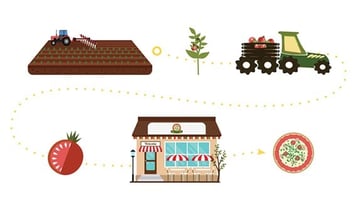Between food allergies, dietary preferences and a consumer culture that is paying closer attention to what goes in their bodies, it’s safe to say your customers like to be informed. They don’t just want to know what’s in their meals—they want to know how it was prepared, where it was grown or sourced and how it was stored in between. From concerns for their own health, to ethical and environmental implications, customers have a vested interest in food safety. Today, consumer transparency is essential.
Rather than resisting this growing trend of diner awareness, your restaurant has an opportunity to offer greater transparency for your customers. By demonstrating that you understand their interests and concerns, you can establish increased trust between your restaurant and your patrons. They’ll have confidence in the product and service they receive and, in turn, you’ll have their continued business and loyalty.
Keep reading to learn three ways you can get started with improved customer transparency.
1. Be Open About Your Supply Chain
Restaurant patrons like knowing that the places they choose to eat have nothing to hide. By publicly tracing your supply chain for the various foods and products used in your restaurant, you can demonstrate to your customers that they can feel safe and assured in their choice to dine with you.
Consider including a section on your website that shows the path various ingredients take prior to ending up on a plate. Or name your suppliers directly on your menu and marketing materials so it’s easy for your customers to find. Being up-front shows diners that your supply chain is a point of pride—not one of secrecy.
2. Make Nutritional Facts and Ingredients Accessible
The ability to make healthy choices while dining out is important for many restaurant patrons, but especially those who follow a specific diet or have food allergies. Rather than worrying about asking a waiter or requesting to speak to the chef, your customers can have a low-stress meal and avoid taking unnecessary health risks.
Beyond simply making this information available, take your transparency one step further and make it accessible. Try creating an engaging app that allows your customers to explore all of the nutritional facts and ingredients for each item on your menu so they can properly plan their meal.
3. Don’t Be Afraid to Get Personal
Part of earning your patrons’ trust is allowing them to get to know you—and that goes deeper than just your branding and signature dishes. Sharing personal stories online through your blog can help bring your restaurant’s purpose and story alive for your customers. For instance, you could publish a Q&A post with a local farmer who grows some of your produce or write a “day in the life” post featuring your head chef.
Any personal insight into the heart and soul of your restaurant not only can provide the transparency customers want, but it also can help add character and humanize your business. After all, sharing a meal is a personal endeavor—and that connection should go both ways.
The Upside of Customer Transparency
Of course, improving customer transparency isn’t only about doing what’s best for your customers. By creating an atmosphere of trust and a commitment to your customers’ needs, you can encourage more repeat diners, improve your restaurant’s reputation and increase your profitability. In short: Everybody wins.
Having the right data is the key to transparency. Learn more about FoodLogiQ traceability solutions and how you can arm your staff with the right information.
Other posts you might be interested in
View All Posts
Traceability
6 min read
| February 22, 2024
Understanding Critical Tracking Events
Read More
4 min read
| December 11, 2019
Crafting the Case for Traceability: How to Gain Buy-in from Executive Leadership
Read More
Food Industry
6 min read
| October 8, 2019

